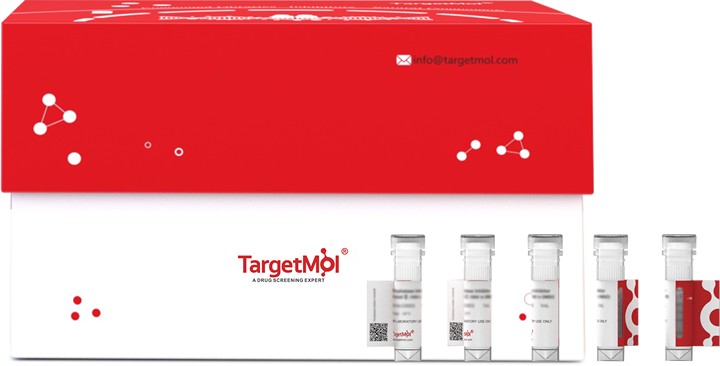- Remove All
 Your shopping cart is currently empty
Your shopping cart is currently empty
Shopping Cart
ENO1 Protein, Mouse, Recombinant (His)
Catalog No. TMPH-02505
Glycolytic enzyme the catalyzes the conversion of 2-phosphoglycerate to phosphoenolpyruvate. In addition to glycolysis, involved in various processes such as growth control, hypoxia tolerance and allergic responses. May also function in the intravascular and pericellular fibrinolytic system due to its ability to serve as a receptor and activator of plasminogen on the cell surface of several cell-types such as leukocytes and neurons. Stimulates immunoglobulin production. ENO1 Protein, Mouse, Recombinant (His) is expressed in E. coli expression system with N-6xHis tag. The predicted molecular weight is 50.9 kDa and the accession number is P17182.

ENO1 Protein, Mouse, Recombinant (His)
Catalog No. TMPH-02505
Glycolytic enzyme the catalyzes the conversion of 2-phosphoglycerate to phosphoenolpyruvate. In addition to glycolysis, involved in various processes such as growth control, hypoxia tolerance and allergic responses. May also function in the intravascular and pericellular fibrinolytic system due to its ability to serve as a receptor and activator of plasminogen on the cell surface of several cell-types such as leukocytes and neurons. Stimulates immunoglobulin production. ENO1 Protein, Mouse, Recombinant (His) is expressed in E. coli expression system with N-6xHis tag. The predicted molecular weight is 50.9 kDa and the accession number is P17182.
| Pack Size | Price | Availability | Quantity |
|---|---|---|---|
| 20 μg | $284 | 20 days | |
| 100 μg | $590 | 20 days | |
| 1 mg | $2,530 | 20 days |
Bulk & Custom
Add to Cart
Select Batch
Resource Download
Product Information
| Biological Activity | Activity has not been tested. It is theoretically active, but we cannot guarantee it. If you require protein activity, we recommend choosing the eukaryotic expression version first. |
| Description | Glycolytic enzyme the catalyzes the conversion of 2-phosphoglycerate to phosphoenolpyruvate. In addition to glycolysis, involved in various processes such as growth control, hypoxia tolerance and allergic responses. May also function in the intravascular and pericellular fibrinolytic system due to its ability to serve as a receptor and activator of plasminogen on the cell surface of several cell-types such as leukocytes and neurons. Stimulates immunoglobulin production. ENO1 Protein, Mouse, Recombinant (His) is expressed in E. coli expression system with N-6xHis tag. The predicted molecular weight is 50.9 kDa and the accession number is P17182. |
| Species | Mouse |
| Expression System | E. coli |
| Tag | N-6xHis |
| Accession Number | P17182 |
| Amino Acid | SILRIHAREIFDSRGNPTVEVDLYTAKGLFRAAVPSGASTGIYEALELRDNDKTRFMGKGVSQAVEHINKTIAPALVSKKVNVVEQEKIDKLMIEMDGTENKSKFGANAILGVSLAVCKAGAVEKGVPLYRHIADLAGNPEVILPVPAFNVINGGSHAGNKLAMQEFMILPVGASSFREAMRIGAEVYHNLKNVIKEKYGKDATNVGDEGGFAPNILENKEALELLKTAIAKAGYTDQVVIGMDVAASEFYRSGKYDLDFKSPDDPSRYITPDQLADLYKSFVQNYPVVSIEDPFDQDDWGAWQKFTASAGIQVVGDDLTVTNPKRIAKAASEKSCNCLLLKVNQIGSVTESLQACKLAQSNGWGVMVSHRSGETEDTFIADLVVGLCTGQIKTGAPCRSERLAKYNQILRIEEELGSKAKFAGRSFRNPLA |
| Construction | 2-433 aa |
| Protein Purity | > 90% as determined by SDS-PAGE. |
| Molecular Weight | 50.9 kDa (predicted) |
| Endotoxin | < 1.0 EU/μg of the protein as determined by the LAL method. |
| Formulation | Tris-based buffer, 50% glycerol |
| Reconstitution | A Certificate of Analysis (CoA) containing reconstitution instructions is included with the products. Please refer to the CoA for detailed information. |
| Stability & Storage | Lyophilized powders can be stably stored for over 12 months, while liquid products can be stored for 6-12 months at -80°C. For reconstituted protein solutions, the solution can be stored at -20°C to -80°C for at least 3 months. Please avoid multiple freeze-thaw cycles and store products in aliquots. |
| Shipping | In general, Lyophilized powders are shipping with blue ice. Solutions are shipping with dry ice. |
| Research Background | Glycolytic enzyme the catalyzes the conversion of 2-phosphoglycerate to phosphoenolpyruvate. In addition to glycolysis, involved in various processes such as growth control, hypoxia tolerance and allergic responses. May also function in the intravascular and pericellular fibrinolytic system due to its ability to serve as a receptor and activator of plasminogen on the cell surface of several cell-types such as leukocytes and neurons. Stimulates immunoglobulin production. |
Dose Conversion
You can also refer to dose conversion for different animals. More
Calculator
Tech Support
Please read the User Guide of Recombinant Proteins for more specific information.
Keywords

Copyright © 2015-2025 TargetMol Chemicals Inc. All Rights Reserved.


